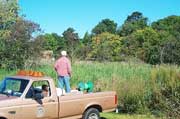
|
|
 |
||||||||
|
Volume 13, Issue 37 ~ September 15 - 21, 2005
|
||||||||||
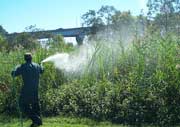 Battling Alien Invaders Battling Alien InvadersMaking war on phragmites and other flora that take no prisoners by Carrie Steele It’s not a glamour job, tromping through the marsh in hip-waders and canvas jumpsuit to slash through thick, endless clumps of reeds in the hot sun. Sometimes it reeks. The smell is really bad, says Mark Smith of Maryland Department of Agriculture. Sometimes at day’s end, it takes more than one shower to wash it off. Sometimes it’s hard to see the trees for the forest, too. Slip into a camouflaged, booby-trapped four-foot-deep creek, and water shoots over your waders, while thick mud holds onto your boots like the Jaws of Life. Fighting the Battle On a sunny autumn morning, Smith and Judy Edelen pulled their khaki Department of Agriculture pickup near their targets: patches of phragmites on a two-acre private lot near the Severn River Bridge in Annapolis. 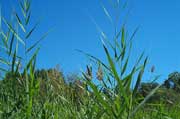 “It was so thick, the homeowners couldn’t even see the river,” says Smith of the enemy. “Phragmites just keep creeping in; these homeowners are trying to recapture their land.” “It was so thick, the homeowners couldn’t even see the river,” says Smith of the enemy. “Phragmites just keep creeping in; these homeowners are trying to recapture their land.”Smith and Edelen, who work for the Office of Plant Industries and Pest Management at Maryland’s Department of Agriculture, were responding to a homeowner’s repeated cry for help. They’ve been at this very spot before with the big herbicide tank, pump motor and yards of hose to rescue yet another tideline from the grip of aliens. But the invaders return, no matter what Smith does or how much poison he spreads. The duo treated this area before Hurricane Isabel, only to have the storm wreck their work. To kill, their herbicide must flow down the plant stem into the rhizomes, underground stems that generate new roots and shoots. In the storm, many of the shoots broke off and Roundup’s work was interrupted. The reeds came back. “Phragmites just out-competes everything in its niche,” says Smith. “It says ‘this niche is mine.’” Areas where Smith and Edelen had managed to banish the leafy intruders have sprouted a diversity of native plants: switch grass, persimmon, mares’ tail and more plants that know how to share habitat. “Let’s see what good we can do,” Smith says over his shoulder before disappearing into the phragmites jungle. Smith trailblazes, fighting through the dense reed wall to get to the starting point. Then he sprays his way back to the truck. His green sprayer hose trails behind him like a lifeline. But it’s really a death line, for through it Roundup is propelled from the tank over the phragmites. “Sometimes I can’t even tell where he is in the phragmites patch except for seeing the spray,” says Edelen. Smith sprays 100 gallons on the stalks and leaves until the leafy stand glistens. Once the herbicide is absorbed through the leaves, it gets into the plant’s system, killing roots, shoots and all. Smith and Edelen take such phragmites-busting trips three or four times a week in the late summer and early fall. Invasion of the Wetland Snatcher It’s all in the strategy. When tribes or groups invade other lands and countries, armies either swarm in or sneak undercover by the black of night. Invading plants use both these strategies. Like the infamous northern snakehead fish, non-native plants, too, can get too big for their niches. Vines, bushes, shrubs, trees, grasses and water plants invade, ravaging their conquered territory. In the Florida Everglades, the Chesapeake’s distant, marshy cousin, such invaders as old world climbing fern have blanketed the river of grass in lovely green death. In Chesapeake Country wetlands, we battle phragmites austrais, the common reed. Armies of phragmites have invaded Maryland wetlands, forming thick stands that choke out native plants and starve out resident wildlife. The reed has conquered as much as 50,000 acres in Maryland, according to U.S. Fish and Wildlife Service biologist Doug Forsell’s best guestimate. That’s nearly 50 times the acreage of pumpkins grown in Maryland last year. Forsell bases his figure on a mid-1990s survey that found 8,500 acres of phragmites just along the Bay’s wet borders. “I’d guess that amount has at least doubled or tripled since then,” he says. “And that number doesn’t even reflect acres of phragmites plaguing creeks and streams not directly on the Bay. There’s gobs of phragmites that aren’t on the edges of the Bay.” Department of Natural Resources does not take a census of phragmites, but Jonathan McKnight, associate director of habitat conservation at the department, calls it “the worst wetland invasive plant on the Chesapeake.” Worse yet, the numbers keep growing. “The difficulty is that it spreads every year,” McKnight said. It’s creeping into wetlands near and far. Maryland’s battle is one repeated all over the East Coast. Drive north along I-95, and you’ll realize that Maryland isn’t the only state with plant battlegrounds: Phragmites line the highways in some areas. Fields brimming with phragmites taunt New York City’s skyline. There’s probably an invasion very near you. Walking past a stand of phragmites is like walking next to bamboo or a leafy wall. The constant, soft rustling of their long leaves sounds like a rainstick turned upside down. Don’t be fooled by their peaceful and calm demeanor: they’re not to be trusted. “If your house is near the water,” says U.S. Fish and Wildlife Service’s Julie Thompson, “it could be overwhelmed if just a couple plants become established.”
Natives of Europe that have immigrated worldwide, phragmites are perennial grasses that can grow to 20 feet tall. The name comes from the Greek word phragma, which means fence, a reference to its density. They’re a pretty problem. The stalk bears long, thin leaves that ribbon into a point. The flowers rise from the reeds in plumes that look like feather dusters. These grasses creep along tide lines, stalking nearly fresh and brackish wetlands and lakes and streams. As eager as they are to establish their extensive root systems, they’re picky about how wet their feet can be, growing only in semi-dry areas in and adjacent to wetlands. Phragmites doesn’t really like deeper water areas, says Smith. Otherwise, its tastes are broad. It can endure acidic soils, standing water and fresh or brackish wetlands. Its favorite spots, however, are recently disturbed areas, where it can grab a spot of bare land. Like insurgents, phragmites sprawls underground. The root system creeps under the soil, shooting up new stalks and expanding the colony like a giant form of crabgrass. Once phragmites has colonized, there’s no return for native plants, which are no match for these matted rhizomes and dense clusters. Phragmites can also spread by seeds, which grow on their plumed heads and drop or drift into nearby soils to begin a new colony. “It’s very good at transporting itself,” said McKnight. “When big chunks of rhizomes break off and float around or when seed distributes, it’s like mold in a Petri dish.” Adds Smith, “As a wetland species in that niche, phragmites has the playing field to itself.” A Dangerous Foe The ability to occupy acres is the characteristic that makes phragmites infamous. “From a biosphere standpoint, it’s extremely serious,” says Smith. “It’s crowding out indigenous species and destroying habitat.” Dense forests of phragmites leave little room for diversity, which is the heartbeat of ecology. The more diverse your flora, the more diverse your fauna, says Smith. Some species, such as red-winged blackbirds, can make their home in phragmites, but by and large the mono-culture that phragmites creates makes a wetland much less diverse. Because wetlands host waterfowl, they support an ecology that stretches across continents. Our greatest density of wetlands is on the Eastern Shore. Once phragmites are removed, native plants have a chance to come back. “Native vegetation comes back much faster in freshwater areas than in brackish, because there’s more species,” says Fish and Wildlife’s Thompson. But getting rid of phragmites is a big job. “None of us are fooling ourselves that we’ll eradicate phragmites in the near future,” McKnight said. Dollars Are No Match for Weeds Where phragmites puts down roots, it absorbs dollar signs. A couple hundred acres of phragmites can cost $5,000 to $10,000 per year to treat, says Maryland Department of Natural Resources’ waterfowl habitat manager Donald Webster. “Even 50 acres to me would be costly,” he adds. This year, only 2,500 acres of phragmites has been targeted for destruction. To poison, slash and burn that fraction of the invading army, many Maryland and federal agencies mobilize forces and dollars. For the work of soldiers like Smith and Edelen and for chemicals bought to control phragmites, Department of Agriculture says it doesn’t spend a dime. That’s because the program pays for itself with revenue earned from landowners who hire agriculture staffers as mercenaries to fight the invader, according to Mark Smith of the Office of Plant Industries and Pest Management. Maryland Department of Natural Resources also gets involved because their Wildlife and Heritage program works to conserve diverse native wildlife, plants and the natural communities that support them. To help control phragmites on the property of some 400 to 600 landowners who seek help, the department spends some $50,000 each year, according to Webster. Landowners can also appeal to the Federal Wildlife Habitat incentive program for federal funds that can amount to up to 75 percent of their costs. U.S. Fish and Wildlife Service spends a couple more thousand dollars each year, according to Thompson, to wrangle phragmites. Their first priority is not private land but wildlife management areas. “We focus on major preserves, areas where there’s extensive phragmites, such as Chesapeake Bay Environmental Center in Grasonville,” Thompson says. Private landowners are a second priority. Other non-profit groups are allies in the war. Chesapeake Wildlife Heritage, an Easton-based conservation group that helps public and private landowners manage for sustainable agriculture and wildlife habitat, spends $17,000 to $20,000 annually to help landowners fight phragmites. In 2000, Maryland spent $1.8 million to battle invasive plants, according to Carol Holko of the not-for-profit Maryland Invasive Species Council. “We have nowhere near enough resources in the state,” she said. “There’s more organized programs to battle invasive animals and insects, but funding for weeds is pretty dismal.” Meanwhile, in the Everglades In contrast to Maryland’s piecemeal struggle against alien invaders in Chesapeake Country, Florida has mounted an organized campaign to rid its comparable treasure, the Everglades, of plant invaders bent on running out native species. To fight invasive species, last year the South Florida Water Management District spent $25 million. That’s about 14 times what Maryland spends annually. Top among the expansive invading army is lygodium, that old world creeping fern, and melaleuca, a paper-bark tree from Australia that grows in almost any environment or soil. In its native land, over 400 insects eat melaleuca. In the Sunshine State, nothing does, so the tree spreads unchecked, like our phragmites. “With a longer growing season, we’re seeing problems reach us obvious early,” said Dan Thayer, head of exotics program for the South Florida Water Management District, which manages water resources for a broad swath of Florida that includes the Everglades. With such prime growing conditions, Florida’s everglades are constantly under attack from invasives. “We have thousands of acres where no other plant can be found,” Thayer said. “They come without the complement of herbivores and diseases that keep it checked naturally, so they have a competitive edge.” Still, Florida is fighting back. “We’ve removed 80 percent of the melaleuca on public lands through a long battle,” says Thayer of a campaign fought by air and tree to tree by foot soldiers. “We’ve made good process.” In Maryland, however, invaders — of many kinds — have got the upper hand.
Phragmites is the northern snakehead of the plant world, but it’s not our only invasive flora. Rumor has it that phragmites was brought over from Europe in the late 1700s as stowaways on ships. Many other plant invasives often arrive as invited guests — until they crowd out native species. Among such alien invaders are kudzu, mile-a-minute, multi-flora rose, hydrilla, honeysuckle, Chinaberry, wisteria and English ivy. Most were planted for looks or ground cover. Lots of non-native plants earn their welcome. “Like tulips,” says Patuxent Refuge biologist Marilyn Eames, who organizes raiding parties of Weed Warriors. “You don’t see tulips running amok.” Running amok is what makes an alien a pest. Kudzu is a terrestrial vine that, like phragmites, preys on disturbed land. Maryland’s biggest infestations can cover some six acres, but kudzu most often gobbles half- to one-and-a-half-acre areas. And like phragmites, kudzu’s occupied territory is uncharted. What is known, says DNR’s McKnight, is that numbers are growing larger each year. Yet, he adds, “we don’t have any major funding initiatives for kudzu.” Even kudzu is more manageable than phragmites. Because it’s a terrestrial vine, “it’s much easier to get to,” says Department of Agriculture’s Smith. The Maryland Invasive Species Council — a group of 35 scientists, land managers, government reps and concerned citizens formed in 2000 — lists 44 invasive plants to watch out for. That’s along with seven plant viruses and fungi, and 30 insect, invertebrates and vertebrate invaders. Invasives even compete with each other at times: “Sometimes mile-a-minute will actually grow over the top of phragmites,” says Smith. The mile-a-minute vine, with its tiny thorns and energy to live up to its name, has to be treated before sprayers can even get to the phragmites. As Eames and her Weed Warriors pulled mile-a-minute off of Japanese barberry last month, they found Japanese beetles dining on the triangular leaves. “In these cases, it’s almost a chicken and the egg question,” said Eames: Is it better to have an invasive pest eating an invasive plant rather than a native plant? The answers lead to more questions, unknown factors and road blocks, creating webs of reasoning that almost mimic the intruder vines themselves. But as for the invasives, they’re single-minded: All they want is to survive and reproduce. They’ll reach those goals by any means.
Phragmites traveled as an intrastate stowaway onto Patuxent Wildlife Refuge’s North Tract. “We don’t have a lot of phragmites, but what we do have is the result of construction,” said Eames, a biologist at Patuxent Research Refuge, where there are plans to spray herbicide on the seven to eight patches this month. “I hope we can knock it out hard. It’s been here for 10 years.” She’s hoping for another success like the banishing of purple loosestrife. That slender stem lined with small leaves and tiny orchid-purple flowers once dwelled on refuge soils but was pulled off by biologists and volunteers several years ago, Eames reports. It’s only one species, but it’s proof that Patuxent Research Refuge doesn’t take plant invasion lightly. On one sunny August morning, it was the tenacious mile-a-minute vine that was under attack. Eames led a team of four Weed Warrior volunteers into the refuge to thread the wire-thin vines and triangular leaves out from tree branches. Volunteers balled up the vines as they snaked into the underbrush, tracing the prickly threads down through grape vines, shrubs and other plants until they reached the shallow, reddish roots drawing up from the soil. “It’s annoying-prickly,” said Kate Toniolo, outdoor recreation planner for the refuge. “You can feel the thorns but not see them.” That’s why volunteers Eric Tang from Clarksville and Martin Liu from Ellicott City, both high school juniors, donned heavy gloves before snaring mile-a-minute from leafy branches five feet above their heads and entangled around shrubs. “Hand-pulling is the most effective way to treat this invasive,” said Eames. “It absolutely makes a difference.” The name mile-a-minute may be an exaggeration, but at six inches a day, this invader can quickly block sunlight to trees and shrubs. By the side of a dirt road at the North Tract, it doubled back over itself, creating mats of leaves and vine, entangling anything in its path. “This one never ends,” said Toniolo as she wrestled her two-foot-wide ball of mile-a-minute, thought to be imported from Japan as an ornamental. “Invasives love disturbance. They just take off,” said Eames. Gripping the lush green vines, Eames and her team of volunteers were equally concerned with confiscating the blue berries, each about the size of a peppercorn kernel, that are the main spreaders of these plants. “Birds eat the seeds and defecate them into new areas,” Eames said. Add a little direct sunlight, and mile-a-minute’s sprouts could mean the end of nearby foliage. “Anyone can get it out of their backyard,” Eames said, so that birds can’t spread the seeds. After an hour and a half of hand pulling, yielding four large garbage bags of mile-a-minute, Eames called it quits. “I’d say we put a very significant dent in it,” she said as the team of five loaded back into the car for the ranger station, where Technu was slathered on to prevent poison ivy, an invasive native. On the way back to the ranger station, Eames sighed as she gazed out on new patches of mile-a-minute cloaking the shapes of trees and shrubs, “Oh, look! It’s all over to the left.” Though smarting from Technu, her two high school students left feeling victorious. “It was fun,” said Tang. “I want to come back and do it again.” Rooting out the Problem At the Patuxent Research Refuge, many more recruits help battle invasives. Among helpers are the Maryland Native Plant Society, Anne Arundel Master Gardeners, Maryland Department of Natural Resources, the Friends of Patuxent and more. The refuge has also joined with Fort Meade to capture a $17,400 matching grant from the National Fish and Wildlife Foundation to control invasive species on both properties. Protection for wildlife habitats often includes money for fighting invasives. Three weeks ago, $905,000 from the U.S. Fish and Wildlife Service created the Maryland Landowner Incentive Program to restore habitat for rare and threatened plants and animals inhabiting private lands. The voluntary, cost-share program reimburses landowners up to 75 percent of the cost in restoring habitat for declining species such as dwarf wedge mussel and bog turtle, both of which are federally listed species. Maryland has more than 600 plant and animal species at risk, and most survive on private land. On the horizon also is a newly formed regional panel for aquatic nuisances, which targets phragmites. And under the Chesapeake 2000 agreement, phragmites is one of six species with planned management. “We’re not putting a dent in phragmites, but we’re able to keep some of these wetlands more diverse,” says DNR’s Webster. “At the best we’re just breaking even. There’s just not enough money in coffers. We’re not ever going to be phragmites free in Maryland.” But that doesn’t stop people from dreaming. “Eradication would be wonderful,” says Kerrie Kyde, habitat ecologist at DNR. “But in practical terms, it’s reduction” that we can hope for — at best. Annoyance and Awe Whether you’re battling the reedy invaders in your own yard or dreading encroachment on your favorite park, landowners, volunteers and state agencies are pushing back phragmites in Chesapeake Country wetlands. That a plant can create so much stir is in itself amazing. “We were in phragmites the other day that were easily 20 feet tall,” says Smith. “Think of the amount of biomass that it creates every year. Its ability to thrive is really impressive.”
Department of Agriculture can help you fight your way through the jungle of paperwork, too. “We help the landowner apply for wetlands permit and bring in expertise in getting herbicides applied,” says Mark Smith of Maryland Department. Department of Agriculture works mostly with homeowners and people who have fewer than 200 yards of river frontage. It also fights phragmites in areas where helicopters can’t go for security or other reasons, says Smith. The property by Severn River Bridge, for instance, is too close to the Naval Academy for a helicopter pass. A few non-profits in the area are pitching in to help landowners, too. Chesapeake Wildlife Heritage offers assistance to landowners in Anne Arundel County and the Eastern Shore. Its goal is to spray hundreds of acres of phragmites this fall with herbicide, says the organization’s Sandy Parker. Only in the past three years has the state been chemically treating these armies of invasives. “Ideally, we can take care of a small patch before it gets to be a 200-acre patch,” said McKnight. Get advice or assistance in removing phragmites on your property from Maryland Department of Natural Resources (410-827-8612) or Department of Agriculture (410-841-5871). Find more information on invasive plants in Maryland at www.mdinvasivessp.org.
|
||||||||||
|
|
||||||||||
|
© COPYRIGHT 2004 by New Bay Enterprises, Inc. All rights reserved. |
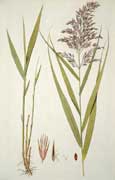

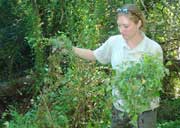
 About the Author
About the Author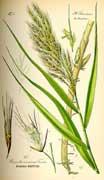 Fighting Back
Fighting Back